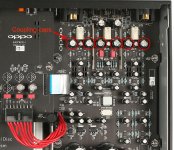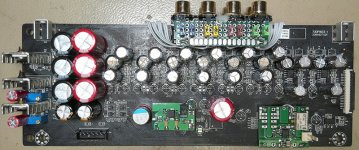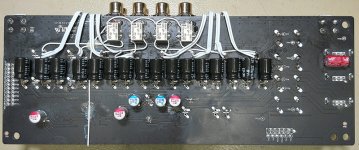DAC board 203 (RCA analogue outputs)
Some considerations about the analog audio board in 203.
The DAC board in 203 it was meant as a cheap analogue solution for monitoring audio multi-channels. This board it use a cheap DAC chip with voltage output.
The mute circuits are electronic. Because the DAC voltage output, and its virtual ground approach, the DC offset on DAC outputs is 2,5v - 2,9v. The AC coupling for post DAC circuit is a must in this case (Oppo used polarised caps of a relative low capacity). Because the electronic muting solution, there is necessary another AC coupling stage in between the post DAC opamp and the mute circuit. Too many AC coupling stages in signal path, in my opinion... And the transistor mute circuit I do not like it at all.
What about the post DAC circuit itself? Well, here is about a very good design in my opinion. Simple (only one double opamp - NE5532), not the best parameters opamp, making the conversion balanced (DAC output) to unbalanced (RCA) signal output. What is excellent with this post DAC amp stage is its DC offset. In between 0 and 2mV on all channels (better than for 205 and another Oppo models). This excellent DC offset which it allow a full DC coupling for all outputs is also unused, and spoiled by the existence of a electronic mute circuit, which it force the second AC coupling in between...
There is a way to do it right? Well, there is...
My first modification approach was improving the power system on board (the cutting production costs is obvious in this area). Also the power system around the DAC chip is improvable as well. Then doing it right about the post DAC power system and circuits itself. I cut it out the electronic mute stage, and replace it with relays. Well, this is good for audio signals, but not so good for the device power system, as despite my precautions, it still take 100mA from device main DC power. I used the USB power system for these relays, and a 555 circuit to realise the mute at power on sequence. Mute at power on is a must, as the DC offset variation is very big at start up.
Well, some other corrections of the original design for this board, and BINGO! Exceptional analogue audio out, with just amazing dynamics, channel separation, depth and large sound scene for stereo. Not tested yet for multi-channel configuration, but I am sure the result is the same excellent. Another improvement option is adding my fully balanced post DAC module, for stereo XLR outputs. In this case I take the signals directly from AK4458 Front L/R ouputs. XLR connectors are also added on rear panel. The quality for stereo is even higher in such case...
I can only say that this modified board it can deliver the similar quality on the all audio outputs, as an 205 (SabrePro DAC chip inside). Very surprising for a cheap, and medium to low quality meant analogue output. The AK4458 is a very capable DAC chip indeed, when implemented right, and feed it with quality power... Also my LPS it provide the main DC power to the digital system, and audio board as well.
It is pictured hereby my modified audio board of 203 (both sides). The AC coupling is present on board (and improved) on all outputs, but I added a switching option (AC/DC coupling) for a more convenient choosing of the preferred approach by the user, to fit best the further connected gear. Best quality is off course on DC coupling.
Some considerations about the analog audio board in 203.
The DAC board in 203 it was meant as a cheap analogue solution for monitoring audio multi-channels. This board it use a cheap DAC chip with voltage output.
The mute circuits are electronic. Because the DAC voltage output, and its virtual ground approach, the DC offset on DAC outputs is 2,5v - 2,9v. The AC coupling for post DAC circuit is a must in this case (Oppo used polarised caps of a relative low capacity). Because the electronic muting solution, there is necessary another AC coupling stage in between the post DAC opamp and the mute circuit. Too many AC coupling stages in signal path, in my opinion... And the transistor mute circuit I do not like it at all.
What about the post DAC circuit itself? Well, here is about a very good design in my opinion. Simple (only one double opamp - NE5532), not the best parameters opamp, making the conversion balanced (DAC output) to unbalanced (RCA) signal output. What is excellent with this post DAC amp stage is its DC offset. In between 0 and 2mV on all channels (better than for 205 and another Oppo models). This excellent DC offset which it allow a full DC coupling for all outputs is also unused, and spoiled by the existence of a electronic mute circuit, which it force the second AC coupling in between...
There is a way to do it right? Well, there is...
My first modification approach was improving the power system on board (the cutting production costs is obvious in this area). Also the power system around the DAC chip is improvable as well. Then doing it right about the post DAC power system and circuits itself. I cut it out the electronic mute stage, and replace it with relays. Well, this is good for audio signals, but not so good for the device power system, as despite my precautions, it still take 100mA from device main DC power. I used the USB power system for these relays, and a 555 circuit to realise the mute at power on sequence. Mute at power on is a must, as the DC offset variation is very big at start up.
Well, some other corrections of the original design for this board, and BINGO! Exceptional analogue audio out, with just amazing dynamics, channel separation, depth and large sound scene for stereo. Not tested yet for multi-channel configuration, but I am sure the result is the same excellent. Another improvement option is adding my fully balanced post DAC module, for stereo XLR outputs. In this case I take the signals directly from AK4458 Front L/R ouputs. XLR connectors are also added on rear panel. The quality for stereo is even higher in such case...
I can only say that this modified board it can deliver the similar quality on the all audio outputs, as an 205 (SabrePro DAC chip inside). Very surprising for a cheap, and medium to low quality meant analogue output. The AK4458 is a very capable DAC chip indeed, when implemented right, and feed it with quality power... Also my LPS it provide the main DC power to the digital system, and audio board as well.
It is pictured hereby my modified audio board of 203 (both sides). The AC coupling is present on board (and improved) on all outputs, but I added a switching option (AC/DC coupling) for a more convenient choosing of the preferred approach by the user, to fit best the further connected gear. Best quality is off course on DC coupling.
Attachments
Last edited:
Referring to the above post.
I have in the end, replaced the original NE5532 opamps with OPA1612 (only for stereo channels so far). Even better analogue sound out of an 203...
The transistor mute circuits it have not a perceptible impact over the quality of outputted audio signal, but for taking benefit (DC coupling) of the excellent DC offset of the buffer stage, one should replace it with mute relays. I think it is a little bit stupid using AC coupling on an output with an DC offset not exceeding 1mV...
I have in the end, replaced the original NE5532 opamps with OPA1612 (only for stereo channels so far). Even better analogue sound out of an 203...
The transistor mute circuits it have not a perceptible impact over the quality of outputted audio signal, but for taking benefit (DC coupling) of the excellent DC offset of the buffer stage, one should replace it with mute relays. I think it is a little bit stupid using AC coupling on an output with an DC offset not exceeding 1mV...
After many mods on 205 players, I would like to warn the 205 owners about poor original soldering for the rectifier bridges on stereo board. The poor contact for these bridges with the traces on board it may get worse in time as well.
So, my advice for 205 owners (with basic soldering skills), is remaking the soldering for these components (if not replaced with another rectifier approaches).
So, my advice for 205 owners (with basic soldering skills), is remaking the soldering for these components (if not replaced with another rectifier approaches).
Sorry for asking, are you sure you measured on right power pins of the opamps? If your device is working, is not possible having +/-0,5v on power pins of the opamps. If the device (its analogue outputs) is not working, then it have to be a short somewhere. If so, then the protection circuits on stereo board it will shut down the whole device.
The +12v regulator is used in Oppo original design to power all the relays on board in addition to the opamps, and the AVCC regulators for DACs, as well. -12v regulator it power only the negative rails of the opamps.
The +12v regulator is used in Oppo original design to power all the relays on board in addition to the opamps, and the AVCC regulators for DACs, as well. -12v regulator it power only the negative rails of the opamps.
Ah, sorry if I wasn't clear, I meant about 0.5 volt less - i.e. +/-11.5v and not +/-12v....
Yeah, maybe my understanding it was not just right as well... That voltage drop is quite normal, so the board it was designed... Not an issue however.
Last edited:
Can anyone give some advice on firmware upgrade for my Oppo 203 please?
I have tried to upgrade to the latest version from USB but just get a message saying 'cannot find a valid firmware upgrade file'. I have tried two different USB sticks and downloaded the file from two different laptops but with the same result.
If I try to upgrade from network I get 'cannot connect to server'
I have tried to upgrade to the latest version from USB but just get a message saying 'cannot find a valid firmware upgrade file'. I have tried two different USB sticks and downloaded the file from two different laptops but with the same result.
If I try to upgrade from network I get 'cannot connect to server'
First, I will say that it is a difference in between the US firmware and the EU one. The EU firmware is not recognised by a US device, and the opposite.The EU firmware file it should be downloaded from an EU Oppo website (the ones which it still exist...). The US version, downloaded from a US website).
If you try upgrade over the network from a previous custom firmware, then it not work (you get the message "cannot connect to server"). It not work such upgrade from a USB stick too.
Another thing you should try is setting in Menu the device to look automatically for an new firmware. Turn the device off, stick an USB with the firmware in it (the firmware file should be into the root of your USB stick), and then power the player on again. It should look for and find the firmware on your USB stick.
You should also try doing a Factory reset, and then try again upgrading firmware from USB stick, or over network.
If you try upgrade over the network from a previous custom firmware, then it not work (you get the message "cannot connect to server"). It not work such upgrade from a USB stick too.
Another thing you should try is setting in Menu the device to look automatically for an new firmware. Turn the device off, stick an USB with the firmware in it (the firmware file should be into the root of your USB stick), and then power the player on again. It should look for and find the firmware on your USB stick.
You should also try doing a Factory reset, and then try again upgrading firmware from USB stick, or over network.
Last edited:
Can anyone give some advice on firmware upgrade for my Oppo 203 please?
I have tried to upgrade to the latest version from USB but just get a message saying 'cannot find a valid firmware upgrade file'. I have tried two different USB sticks and downloaded the file from two different laptops but with the same result.
If I try to upgrade from network I get 'cannot connect to server'
The player will say that if there's no network connection.
I just tried this on my player. After connecting using WiFi connection and checking for a firmware update, I received: "Congratulations! Your player already has the latest firmware."
So, make sure you are connected to the network, and the player can see the Internet.
Thanks for the advice guys but I am at a loss with this so far! The player is definitely connected to the network, I have tried a factory reset and am using the correct EU firmware from the Oppo site on my USB stick (extracted to root level) but no luck whichever method I try..
Current firmware version is: 20XEUBO-60-0625 if that gives any clues.
Current firmware version is: 20XEUBO-60-0625 if that gives any clues.
Thinking about it, I bought the player as an ex demo unit from B&O. Could the BO in the firmware number be a custom firmware?
Yes indeed... This added "BO" is not just usual for Oppo firmware. Either EU or US after UDP20X. It seems that B&O have used that device for experiments or even tryied an revers software engineering in their benefit. It is very possible that they have installed an modified firmware, which is no longer recognisable by Oppo security check prior installing the upgraded firmware. Such check is done for online upgrades as well. If the checksum is not as it should, then: 'cannot connect to server'...
You should contact they who sold it to you. In my opinion what they did is not just right. An demo product is not supposing to be modified, but used to demonstrate to customers its performances. How and why B&O should demonstrate an Oppo device performances in an B&O showroom is difficult to explain...
Another alternative for you may be forgetting all about, and use your 203 as it is. The latest Oppo firmware for 203 it not bring important improvements...
Last edited:
- Home
- Source & Line
- Digital Source
- Oppo new UDP series players - 203/205 - Discussions, upgrades, modifications


